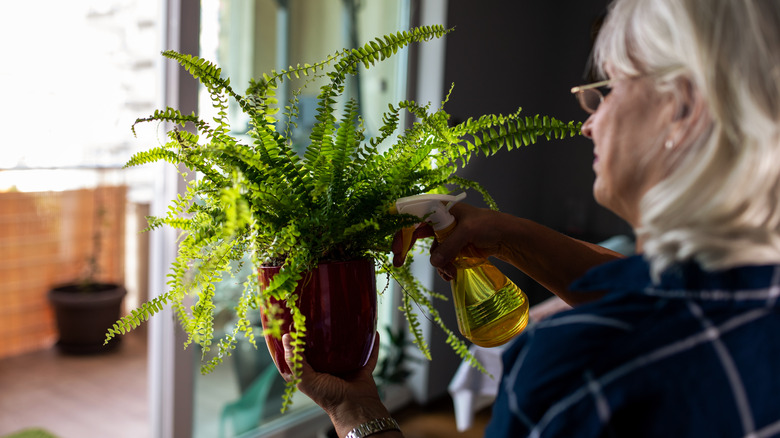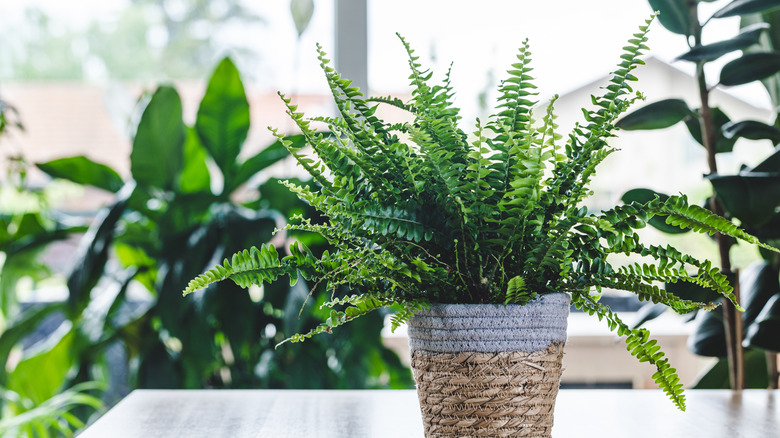How To Revive An Overwatered Fern Plant
Taking care of houseplants can be challenging, and one task that often has to be done carefully is watering. Too little or too much water can have serious consequences. Overwatering can make leaves droopy and yellow, and, even worse, cause roots to rot, which may kill your plant. Ferns are shade-loving plants that like moisture. Many ferns from tropical regions make great houseplants, but too much water can harm them. Here's what to do to revive a fern plant that has been overwatered.
Fern plants grown inside can provide a lovely evergreen display, as long as they're kept healthy and cared for properly. Many ferns like a high-humidity environment, and they require regular watering. But too much water can cause leaves to grow yellow and fall off, or can cause mold to grow on top of the soil. Worst case scenario: Too much watering can cause root rot or various fungal diseases, which could end up killing your fern.
Knowing the most effective way to water ferns can help prevent this from happening. But what can you do when your fern has gotten too much water and needs some TLC to return to health? There are a few easy steps you can take.
Caring for an over-watered fern
If your fern plant suddenly exhibits signs of being unhealthy, overwatering may be the cause. There are several varieties of fern plants popularly grown indoors, and they may have slightly different watering needs. But overwatering usually causes similar symptoms across types. Specific things to look for: leaves that are drooping or wilting, leaves that are turning yellow, or mold on the surface of the soil or growing medium.
The first thing to do is to stop watering your fern. You should also move the container so it's not sitting in water, such as in a dish. Wait for the soil surface to dry out completely before watering again. You should also check the container to make sure the drainage holes are not blocked; if they are, clear them. If there's room in the pot, gently add some dry potting soil or growing medium. This will immediately improve the drainage situation.
You can also try repotting your fern. Gently remove any wet plant material from the root area and lay the fern on some paper towels to let the roots dry out for about an hour. Then place the fern back in its pot (or a new container with better drainage if needed) with some fresh potting soil. Wait a day after repotting and then add some water. Then you can resume watering whenever the top inch of the soil surface feels dry.
Preventing over-watering or too much humidity
Watering ferns may sometimes feel like a delicate dance. They like high humidity, but they hate overwatering. But what's the difference between the two? Humidity refers to the moisture in the air, not just the water added to the soil. When a plant is said to like high humidity, it means the plant thrives when there is plentiful moisture in the air.
Some ferns, like the Boston fern, like a high-humidity environment. But you can accommodate those needs without overwatering. Leaving a dish of water near your fern can help it absorb some humidity from the air. You can also use a plant mister to gently mist your fern's leaves and the soil's surface once or twice per week. If your home tends to have dry air in winter, a humidifier can help add moisture to the air.
The best rule of thumb for watering is to wait until the soil feels dry, then add water until it feels slightly moist, but not wet. Don't water the foliage itself, as this can cause issues with fungus. Some ferns need more watering during the summer months when it's hotter and brighter, like staghorn ferns. However, in winter, heating elements or warm indoor air can also affect your plant's humidity and moisture levels, so you may need to check the soil frequently so you can adjust the watering schedule as needed.


